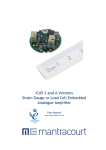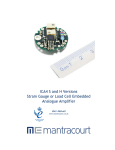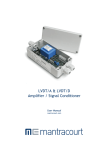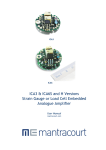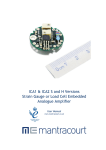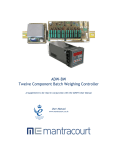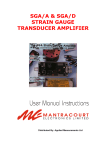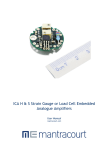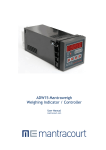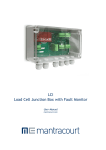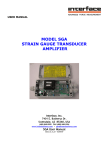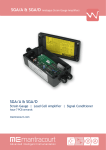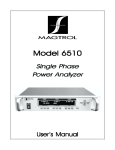Download ICA5 - Load and Force Cells, Indicators and Signal Conditioners at
Transcript
Preliminary ICA5 2 wire 4-20mA Miniature In Cell Amplifier For Strain Gauges www.mantracourt.co.uk ICA5 Manual Contents Chapter 1 Introduction to The ICA Range..............................................................................2 Figure 1.1 Block Diagram .......................................................................................................2 Pre Installation ........................................................................................................................3 Figure 2.1 Dimensions ............................................................................................................3 Power Connections.................................................................................................................4 Figure 2.2 Connection Details ................................................................................................4 Figure 2.3 Connection Details for Best EMC Immunity ..........................................................4 Table 2.1 .................................................................................................................................5 Output Connections ................................................................................................................5 Output Shut Resistance Formula............................................................................................5 Chapter 3 Setting Gain and Offset Values .............................................................................6 Calculating the Gain Resistor (R4) .........................................................................................6 Offset Resistor (R1) ................................................................................................................6 Figure 3.1 Calibration Resistor ...............................................................................................6 Chapter 4 Calibration ...............................................................................................................7 Figure 4.1 Connection Details for Calibration .........................................................................7 Chapter 5 Linearisation............................................................................................................8 Figure 5.1 Bridge Non Linearity ..............................................................................................8 Figure 5.2 Link Options & RLin Locations ..............................................................................8 Chapter 7 Product Care .........................................................................................................12 Chapter 8 Glossary.................................................................................................................13 Chapter 9 Specifications........................................................................................................15 Table 9.1 Specifications........................................................................................................15 Environmental Approvals ......................................................................................................15 Other Mantracourt Products..................................................................................................16 Mantracourt Electronics Limited Preliminary ICA5 User Manual Issue 1.3 1 Chapter 1 Introduction to The ICA Range Figure 1.1 Block Diagram POWER INPUT SUPPLY IN CELL AMPLIFIER Inputs Load Cells Strain Gauges Torque Transducers Pressure Transducers OUTPUT ICA1: 0.1-10V ICA2: 0.1-5V ICA3: ±10V ICA4: 4-20mA ICA5: 4-20mA, 2 wire The ICA is a Strain Gauge Amplifier, converting a strain gauge input to a Volt or mA output – otherwise known as a Signal Conditioner. The ICA provides a wide range of signal conditioning for Strain Gauges, Load Cells, Pressure and Torque Transducers. Offered in 5 versions • ICA1 - 3 wire – 0.1 to 10 volts • ICA2 - 3 wire – 0.1 to 5 volts • ICA3 - 4 wire - ± 10 volts • ICA4 - 3 wire – 4 to 20 mA • ICA5 – 2 wire – 4 to 20mA Special unique features to the 2 wire, 4-20mA amplifier ICA5 Auto zero amplifier giving very high stability Linerisation Screw mounting & earth bonding for EMC Shunt calibration option Operating voltage from as low as 7.5 volts dc Low profile option 7.0mm (0.275”) high ICA5L N.B. The ICA5 is designed for a 1k bridge, however 350R can be used with a reduced performance. This manual only deals with the ICA5 version, separate manuals exist for versions ICA1 & 2, ICA3 and ICA4. Transducer SENSITIVITY of between 0.5 mV/V and 6 mV/V are possible. It is optimized to 2.5 mV/V. Sensitivity adjustment is achieved by a combination of gain (span) resistor ‘R4’ change and associated fine adjustment by potentiometer. Similarly transducer ZERO can be compensated for in the module. This adjustment is to compensate for slight errors in the strain gauge and not to offset tare. The value of R1 (Figure 2.2) can be modified to increase the trim range of the zero point. A high stability resistor, R11 (Figure 5.2) can be fitted to give a greater positive offset e.g. 12mA output at zero input. 2 Mantracourt Electronics Limited Preliminary ICA5 User Manual Issue 1.3 Chapter 2 Installing The ICA5 Pre Installation See Specification Details in Chapter 9 for details of Environmental Approvals. Carefully remove the ICA unit from its shipment box. Check that the unit is complete and undamaged. Check The Model: Type (1,2,3, 4 or 5) – they look similar. The ICA units can operated in any industrial environment providing the following limits are not exceeded Operating Temperature Humidity Storage temperature -40ºC to +85ºC 95% non condensing -40ºC to +85ºC The following installation practices are advised: • • • • • Minimise vibration Do not mount next to strong electrical fields (transformers, power cables) Ensure easy access to the module Install electrical protection device as the unit is not internally fused Always ensure the package is secure and protected Figure 2.1 Dimensions 19.5mm (0.77”) 11mm (0.45”) Miniature size as standard 19.5mm (0.77”) 7.0mm (0.275”) Low profile option (ICA5L) The module is designed to fit in the strain gauge pocket. The low profile (ICA5L) version has single-turn gain potentiometer to reduce the height. Use a bolt through the 2mm hole to secure the unit and to provide a good ground connection. Take care soldering cables to the pads. Use a temperature controlled soldering iron set to a maximum 330 ºC, for no longer than 2 seconds per pad. Excessive heat or increased soldering time may result in damage to the PCB. If changing resistor R1 or R4 do so at a workbench and not on site. Check the relevant details for model ICA5– ensure the module matches the instructions. Mantracourt Electronics Limited Preliminary ICA5 User Manual Issue 1.3 3 The ICA5 solder pads are as shown 4 pads for the strain gauge 2 pads for power supply/signal 4 pads for fitting and linking a calibrating resistor 1 pad for earth bolt to chassis, this is important for best EMC performance Power Connections The power supply for the ICA5 should be between 7.5 and 28V Figure 2.2 Connection Details ICA5 Connection Details PSU 7.5 - 28V Strain Gauge + Supply Com S N.B. For optimum EMC performance bolt the ICA5 to the load cell chassis via this hole The strain gauge cable should be attached to the solder pads as illustrated. N.B The voltage between either of the power supply connections and the load cell chassis should not exceed 50V. Any leakage will be greater than 10M Ohms. Figure 2.3 Connection Details for Best EMC Immunity ICA5 Connection Details for Best EMC Immunity PSU 7.5 - 28V +ve Z + Exc +Exc - Exc S V out Load resistor Screen terminated at EMC gland - In +In - Out Bolt to load cell chassis -ve The securing bolt should be used to provide a good electrical ground and mechanical support. This is important for optimum EMC performance. 4 Mantracourt Electronics Limited Preliminary ICA5 User Manual Issue 1.3 + Out - Exc This typical cable data is provided for information only. The cable should have single pair twisted cables. Table 2.1 Country UK Supplier RS Part No 367-533 Description Braided screened twisted multipair cable (7/0.2mm)- 1 pair Miniature- twin -round Diameter: 4.8 mm Impedance: 62 Ohms: Capacitance/m: core to core 120 pF & core to screen 210 pF Note: For easy connections the above 1 pair cable is recommend, however the ones below can be used: UK Farnell 148-539 UK Farnell 585-646 Individually screened twisted multipair cable (7/0.25mm)- 2 pair Tinned copper drain. Individually screened in polyester tape. Diameter: 4.19 mm Impedance: 54 Ohms: Capacitance/m: core to core 115 pF & core to screen 203 pF Individually screened twisted multipair cable (7/0.25mm)- 3 pair Tinned copper drain. Individually screened in polyester tape. Diameter: 6.86 mm Impedance: 62 Ohms: Capacitance/m: core to core 98 pF & core to screen 180 pF The earth connection conductor should have sufficient cross-sectional area to ensure a low impedance path to attenuate RF interference. Output Connections The ICA5 analogue output is 4 to 20mA. The power and signal are combined in a single pair cable, simplifying installation. N.B. Neither connection to the output load is electrically common to the load cell. The following formula gives the suitable range of shunt resistance for low supply voltage operation. Output Shunt Resistance Formula The shunt resistance must be less than: ((Vsupply -7.5) / 20mA) – Rwiring e.g. assuming 10 Ohms wiring resistance and 9V supply: Max shunt resistance = ((9 - 7.5) / 0.02) –10 = 65 Ohms Mantracourt Electronics Limited Preliminary ICA5 User Manual Issue 1.3 5 Chapter 3 Setting Gain and Offset Values The ICA5 (4 to 20mA) In-Cell strain gauge amplifier is supplied un-calibrated but optimized for a sensitivity of 2.5mV/V. To accommodate other sensitivities the gain resistor ‘R4’ as shown in Figure 2.2, can be changed according to the following formulae. N.B. a high quality component (e.g. 1% 50 ppm metal film device) should be used for optimum performance. It may be necessary to use an E96 value for optimum trim range: - Calculating the Gain Resistor (R4) 40 ∗ ( mV / V ∗ Vexc ∗ 0.048 ∗ 0.95) Rg = = 114 ∗ ( mV / V ∗ Vexc ) 0.016 Where mV / V is the sensitivity of the load cell and Vexc is the excitation voltage. Rg comprises R4 in parallel with 919 Ohms 919 ∗ Rg ∴ R 4 = 919 − Rg e.g. For 2.5mV/V and Vexc = 1V:- Rg = 285 Ohms 919 ∗ 285 ∴ R4 = = 413 Ohms – nearest preferred value is 412 Ohms (E96) 919 − 285 Offset Resistor (R1) The value of R1 can be changed to offset the zero point, if outside of the normal range (± 3%). Figure 3.1 Calibration Resistor There is provision on the PCB to add a (0603) high stability calibration resistor and a ‘solder blob’ link. High stability 0603 calibration resistor Solder blobs to connect calibration resistor across Exc+ and Output+ arm of bridge 6 Mantracourt Electronics Limited Preliminary ICA5 User Manual Issue 1.3 Chapter 4 Calibration Figure 4.1 Connection Details for Calibration PSU 7.5 - 28V An optional 0603 calibration resistor can be fitted here and connected across the Exc+ and Output+ arm of the bridge by the adjacent solder blob pads 1. Apply the low calibration conditions (weight, force or mV/V). Set the output to 4mA using the ‘Z’ potentiometer. 2. Apply the known high calibration conditions (ideally between 75% and full scale) and adjust the ‘S’ potentiometer to give the required output current for the known input. e.g. 16mA for 4-20mA final calibration with 75% input or 20mA if 100% input. Mantracourt Electronics Limited Preliminary ICA5 User Manual Issue 1.3 7 Chapter 5 Linearisation Many bridge sensors are inherently non-linear. With the addition of one external resistor, it is possible to compensate for parabolic non-linearity resulting in up to 20:1 improvement over an uncompensated bridge output. Figure 5.1 Bridge Non Linearity Linearity correction is accomplished by signal-dependant variation of the bridge excitation voltage. This can be tailored to correct for sensor non-linearity between +5 and –2.5%. Either positive or negative bridge non-linearity errors can be compensated for, by proper connection of the polarity pads. (A, B and C Figure 5.2) The ICA5 as supplied is set for negative non-linearity (downward bowing). To correct for positive non-linearity (upward bowing) cut the link connecting pads A and B and join pads B and C with a solder blob. Figure 5.2 Link Options & RLin Locations A B C Rlin R11 If no linearity correction is desired, do not cut the link or remove the resistor RLin. RLin is the external linearisation resistor. To determine the value of RLin, the non-linearity of the bridge sensor with constant excitation voltage must be known. The linearity circuit can only compensate for the parabolic-shaped portions of a sensors non-linearity. Optimum correction occurs when maximum deviation from linear output occurs at mid- scale. See Figure 5.1. Sensors with non-linearity curves similar to that shown in Figure 5.1, but not peaking exactly 8 Mantracourt Electronics Limited Preliminary ICA5 User Manual Issue 1.3 at mid-scale can be substantially improved. A sensor with an ‘S’ shaped non-linearity curve (equal positive and negative non-linearity) cannot be improved with existing correction circuitry. The value of RLin is chosen according to equation 1. (1) 4B RLin = KLin ∗ Ohms 1 − 2B Where: KLin = 9905 Ohms B is the sensor non-linearity relative to Vfs e.g. for –2.5% non-linearity B = -0.025 Vfs is the full scale bridge output ( = Vexc * mV/V) The sensor’s non-linearity term, B (relative to full scale), is positive or negative depending on the direction of the bow. The gain is affected by the varying excitation voltage used to correct bridge non-linearity. The corrected value of the gain resistor is calculated from equation 2. (2) 48 ∗Vfs 1 + 2B Rg = ∗ Ohms 0.4 1 − 2B When using linearity correction, care should be taken to ensure that the sensor’s output common-mode voltage remains within the amplifier’s input range of 1.1V to 3.5V. Equation 3 can be used to calculate the amplifier’s new excitation voltage. (3) 1 + 2B VExc ( Adj ) = VExc (Initial ) ∗ Volts 1 − 2B The common-mode voltage of the bridge output is simply half of this value if no commonmode resistor is used. Exceeding the common-mode range may yield unpredictable results. For high precision applications (errors< 1%), a two-step calibration process can be employed. Firstly, the non-linearity of the sensor bridge is measured with the initial gain resistor and RLin = 0 (RLin pin connected directly to Vreg - this is as supplied). Using the resulting sensor nonlinearity, B, values for Rg and RLin are calculated using equations 1 and 2. A second calibration measurement is then taken to adjust Rg to account for the offsets and mismatches in the linearisation. Mantracourt Electronics Limited Preliminary ICA5 User Manual Issue 1.3 9 Chapter 6 Troubleshooting 1. a) b) c) d) e) f) g) No Output Check power supply is present and the correct polarity Check the output connections are correct with no open circuit connections Check terminations (ensure there are no dry joints) Check the sensor is connected with the power off (Impedance check) Check the Excitation voltage is correct Check the load is connected and is not open or short circuited Check Span and Gain calibration 2. Low Output This is when an output is present but not of sufficient magnitude to meet the required value. Remember to allow for Tare Weight and ensure it is measured and allowed for in the output from the ICA a) Check power supply is within specified limits (i.e. is not low – Impedance check) b) Check the sensor is connected (typically reading 350 Ohm across output + & -) with the power off c) Check the Excitation voltage is at 1.08V dc for a 1k load cell (0.55V for 350R) d) Check the calibration e) Check the Zero (offset) is correct for the sensor, this too is a common reason for low outputs 3. High Output This is when an output is present but higher (in span or zero) than expected. High output is not normally a problem. It is most likely to be incorrect connections and as such the output would be high and fixed. a) Check the sensor is connected (Impedance check) with the power off b) Check the Excitation voltage is at 1.08V dc (assuming a 1k load cell) c) Check the Zero (offset) d) Check the calibration 4. Unstable Output This is when the output is unstable or varies. The cause could be (a) poor installation or (b) a noisy environment. Poor Installation -This is when an output is present but higher or lower (in span or zero) than expected: a) Check the installation for problems and repair where necessary b) Poor termination c) High resistance on cable leads d) Low insulation impedance e) Proximity to High Voltage Equipment – Transformers, Contactors, Motors etc. Noisy Environmenta) Check if the source can be found and remove noise b) Check the cable screening and ensure it is correctly installed and terminated 5. Calibration This section assumes that the unit is providing an output that is not stuck at top or bottom of the scale. (See paragraphs 1-3 if this is the case) Ensure you are connected to the correct sensor and not to another adjacent unit. Ensure you have the correct calibration data from the sensor manufacturer. This must include a certified table with offset, zero and linearity. Ensure you have the calibration set-up correctly installed i.e. mV source and output as required. Ensure the temperature and other environmental parameters are within specification and where necessary taken into account when calibrating should such parameters have an effect on the calibration. 10 Mantracourt Electronics Limited Preliminary ICA5 User Manual Issue 1.3 6. Fine Span (Gain) and Zero (Offset ) Adjustment Problems If the adjustment cannot reach the maximum output desired then, check the tare is not too high. If the potentiometer does not alter the output the unit must be repaired – remove from service. It is always wise to check a known good ICA against the problem Installation before rejecting the suspect ICA. Mantracourt Electronics Limited Preliminary ICA5 User Manual Issue 1.3 11 Chapter 7 Product Care A worn out component, excessive use in harsh environments, an overly zealous operator; regrettably some circumstances necessitate repair. At Mantracourt Electronics Ltd we can't guarantee that a product will never require repairing. We can, however, promise a repair service of exceptional quality, one which is governed by a rigorous procedure. Detailed below is our pledge to you: a defined set of ground rules and procedures to which we will adhere. All we ask in return is that you assist us with our procedure, such that we can maintain our promise to you. Please note that warranty repairs may not be available on overdue accounts, and that a strict interpretation of our conditions of trading invalidates warranty claims where late payment has occurred. Please refer to ‘Customer Repair Service Procedure’ document – contact your supplier for a copy. In the unlikely event you have problems with the ICA module we would advise that you take the following precautions:• • • • • The unit is installed as instructed. Recommended spares are kept in stock. We can assist. Sufficient expertise available for first line maintenance. Routine maintenance checks are performed – annually is recommended. The necessary documentation for the product is available to the maintenance personnel. We recommend you keep on file – as a minimum • This Manual • The calibration figures for the attached sensors • A record of the ‘normal’ output – if applicable • A calibration record of the ICA • A contact phone number from the supplier for assistance 12 Mantracourt Electronics Limited Preliminary ICA5 User Manual Issue 1.3 Chapter 8 Glossary AWG Background Noise Bipolar Bridge Resistance Calibration CMR (Common-Mode Rejection) Common Mode Rejection Ratio Drift Excitation Fine Adjustment Full Bridge Full Range Output Gain Ground/Earth Linearity Load Load Impedance Load Cell Millivolt Noise Null Offset Potentiometer Pressure Transducer Proportional Outputs Resolution Sensing Element Sensitivity American Wire Gauge. The total noise floor from all sources of interference in a measurement system, independent of the presence of a data signal. (See Noise) The ability of a signal conditioner to display both positive and negative readings. The resistance measured across the excitation terminals of a Strain Gauge. Adjustment of an instrument or compiling a deviation chart so that it’s reading can be correlated to the actual value being measured. The ability of an instrument to eliminate the effect of AC or DC noise between signal and ground. Normally expressed in dB at DC to 60 Hz. One type of CMR is specified between SIG LO and PWR GND. In differential meters, a second type of CMR is specified between SIG LO and ANA GND (METER GND). The ability of an instrument to reject interference from a common voltage at its input terminals with relation to ground. Usually expressed in db (decibels). Change of a reading/set point value over periods due to several factors including change in ambient temperature, time and line voltage. The external application of electrical voltage current applied to a transducer for normal operation. Zero and Span calibration have a Fine Adjustment to give accuracy to the calibration. These are potentiometers P1 and P2 for Span and Zero respectively. A Wheatstone Bridge configuration utilizing four active elements or Strain Gauges. The algebraic difference between the minimum output and maximum output. Gain is otherwise identified as SPAN. It relates to the proportional output to the sensor input. Calibration of the ICA is determined by setting the Gain (Span) and Offset (Zero). The amount of amplification used in an electrical circuit. The electrical neutral line having the same potential as the surrounding earth. The closeness of a calibration curve to a specified straight line. Linearity is expressed as the maximum deviation of any calibration point on a specified straight line during any one calibration cycle. The electrical demand of a process expressed as power (watts), current (amps) or resistance (ohms). The impedance presented to the output terminals of a transducer by the associated external circuitry. The load cell is one of a series of STRAIN GAUGE sensors that the ICA input is designed to accept. (Torque Sensor, Pressure & temperature transducers). One thousandth of a volt, 10-3 volts symbol mV. An unwanted electrical interference on the signal wires. A condition, such as balance, which results in a minimum absolute value of output. Offset is otherwise identified as ZERO. Calibration of the ICA is determined by setting the Offset (Zero) and Gain (Span). Two potentiometers (variable resistors) are used in the ICA for fine calibration. The Pressure Transducer is one of a series of Strain Gauge sensors that the ICA input is designed to accept. (Torque Sensor, Load Cell and Temperature Transducers). The Voltage or Current outputs are calibrated to be directly proportional to the input from the sensor. The output is, within the sensor limits, taken as linear and no linearity compensation is required within the ICA. The input corresponding to a one-unit change in the least significant digit of the data acquisition/display equipment. (Good resolution is not necessarily equal to good accuracy.) That part of the Transducer, which reacts directly in response to the input. This is the relationship between the change in Strain Gauge input to the level or magnitude of the output. Mantracourt Electronics Limited Preliminary ICA5 User Manual Issue 1.3 13 Signal Conditioner Single Card Assembly Span Span Adjustment Stability Strain Gauge Strain Gauge Amplifier Torque Transducer Wheatstone Bridge Zero Zero Adjustment Zero Offset Zero Suppression Units AC DC Hz kHz mA mm SC ICA V mV A circuit module that offsets attenuates, amplifies linearizes and/or filters the signal. The ICA is essentially a Signal Conditioner –more specifically known as a Strain Gauge Amplifier - in that it CONDITIONS (alters) the input signal from a load cell to an electrical output. The ICA has only the one Printed Circuit Board assembly on which all the components are mounted. The assembly is then mounted inside an environmentally rugged enclosure. Span is otherwise identified as GAIN. It relates to the proportional output to the sensor input. Calibration of the ICA is determined by setting the Span (Gain) and Zero (Offset). The ability to adjust the gain of a process or strain meter so that a specified display span in engineering units corresponds to a specified signal span. The quality of an instrument or sensor to maintain a consistent output when a constant input is applied. The Strain Gauge is a resistance bridge device where the bridge value alters linearly and proportionally to the force exerted on it – be it pressure, torque or load. The ICA is designed to convert this change in the Strain Gauge to a proportional electrical signal. The ICA1 & 2 is essentially a type of Signal Conditioner that it conditions (alters) the input signal from a strain gauge to an electrical output The Torque Transducer is one of a series of Strain Gauge sensors that the ICA input is designed to accept. A network of four resistance’s, an emf source, and a galvanometer connected such that when the four resistance’s are matched, the galvanometer will show a zero deflection or "null" reading. Zero is otherwise identified as OFFSET. It relates to the proportional output to the sensor input. Calibration of the ICA is determined by setting the Span (Gain) and Zero (Offset). The ability to adjust the display of a process or strain meter so that zero on the display corresponds to a non-zero signal. The difference between true Zero and an indication given by a measuring instrument. See Zero Suppression. The Span is Offset from Zero (Zero Suppressed) such that neither limit of the Span will be Zero. For example, an instrument which measures a load of a 100kG Span from 400kG to 500kG is said to have 400kG Zero Suppression. Alternating Current Direct Current Hertz (Frequency) kilohertz (Frequency) milliamps millimetres Signal Conditioner Strain Gauge Amplifier Volts millivolts 14 Mantracourt Electronics Limited Preliminary ICA5 User Manual Issue 1.3 Chapter 9 Specifications Table 9.1 Specifications Parameter Power supply (reverse protected) Bridge excitation Bridge resistance Bridge sensitivity Gain adjustment (Pot - fine adj.) Zero adjustment (Pot - fine adj.) Output load Bandwidth Zero temperature stability (at 2.5mV/V) Span temperature stability (at 2.5mV/V) Linearity Operating temperature range Humidity Minimum 7.5* 350 0.5 0 -40 0 Typical 24 1.1 1000 2.5 ±3 ±8 0.001 0.007 0.02 - Maximum 28 5000 6 800** 2000 0.005 0.014 +85 95 Units V dc V (1k bridge) Ohms mV/V † (1k bridge) %FS %FS Ohms Hz %FS/ ºC (1k bridge) %FS/ ºC (1k bridge) %FS ºC %RH FS = Full scale. † = set by calibration resistor. **24V supply Connections Solder pads, 4 strain gauge, 2 for power/signal N.B The voltage between either of the power supply connections and the load cell chassis should not exceed 50V. Any leakage will be greater than 10M Ohms. *For low supply voltage operation the shunt resistor must be less than: ((Vsupply -7.5) / 20mA) – Rwiring e.g. assuming 10 Ohms wiring resistance and 9V supply: Max shunt resistance = ((9 - 7.5) / 0.02) –10 = 65 Ohms NOTE: Recommended bridge impedance is 1,000 Ohms Environmental Approvals EMC Emissions EN 50 081-1 EMC Emissions EN 50 081-2 EMC Immunity EN 50 082-1 (RF Fields Test 500 ppm of reading over 30 to 500MHz) EN 50 082-2 (RF Fields Test 6000 ppm of reading over 30 to 500MHz) Low Directive IEC 1010, EN 61010 :1992 (Light industrial) :1992 (Heavy industrial) :1992 (Light industrial) :1992 (Heavy industrial) Mantracourt Electronics Limited Preliminary ICA5 User Manual Issue 1.3 15 Other Mantracourt Products www.mantracourt.co.uk Signal Conditioning SGA • STRAIN GAUGE AMPLIFIER • Connect up to 4 strain gauges • Proportional mA and/or Voltage output • Simple DIL switch configuration • Set Sensitivity and Low pass filter and output • Simple - Reliable - Rugged LCA • IN-LINE INTELLIGENT • STRAIN GAUGE AMPLIFIER • 2 Set Points • 4 to 20 mA AND 0 to 10 V (isolated) outputs • RS 232/485 Communications port • On-Board easy to use Programmer • Auto tare–Auto calibrate–and much more… RCA15 • RACK MOUNTED INTELLIGENT • STRAIN GAUGE AMPLIFIER • Complete MULTI-CHANNEL system for Strain gauges. • Relay and/or serial outputs per channel • Multidrop serial link • 19” Eurorack x 3U high. • Capability similar to the ADW 15. • High integrity / compact Data acquisition unit ADW15 Mantraweigh • 72 mm DIN Module – Display & Controller • 10 mm LED Display (Configurable) • Sensitivity from 0.5 mV to 200 mV/V • 10 V @150 mA Excitation • Isolated I/O100mSec sample rate • Set Point Relays • 4 to 20 mA Output • Programmable via keypad FIELDBUS CONNECTIVITY IN TWO EXCELLENT PACKAGES DSC The Digital Strain Card ‘D’Cell The ‘in-cell’ Digital Strain Puck Mount this package adjacent to the strain gauge Plug-in-and-go-sensor • Integrate the electronics with the load cell, • remove the cost, space and bother of additional electronics and have a direct output • provided in • REAL ENGINEERING UNITS Mount this package directly into the strain gauge pocket High accuracy • A quantum leap in the quality of measurement • Accuracy (1 part in half a million) • Unwanted Signal noise filter • Temperature compensated • Sensor specific calibration • Elimination induced noise on signals ISO 9001 REGISTERED FIRM In the interests of continued product development, Mantracourt Electronics Limited reserves the right to alter product specifications without prior notice. A Doc No. ME 0131 MD 4D Code No. 517-167 Issue 1.3 16 Mantracourt Electronics Limited Preliminary ICA5 User Manual Issue 1.3 09.12.02


















